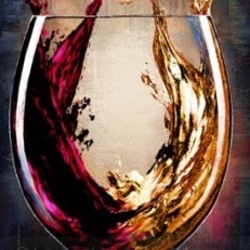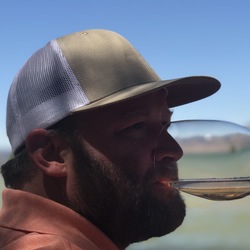Dans La Region De Production
Mulderbosch
Coastal Region Cabernet Sauvignon Rosé 2016
Cabernet Sauvignon vineyards are managed
specifically with the idea of rosé production in
mind. Early picking dates result in naturally high
levels of acidity and a bright spectrum of fruit
flavours ideal in rosé style wines. Once pressed, the juice is handled as per Sauvignon Blanc, i.e. cool fermentation with aromatic yeasts to heighten the vibrant, zesty aromas and fresh mineral palate. Crucial to this style of rosé is early bottling in order to preserve the wine’s inherent freshness.
The 2016 Mulderbosch Rosé exhibits a delicate dusty pink colour reminiscent of classic dry Rosé styles. Bracing mineral aromatics and floral notes are found on the nose whilst the well balanced and vibrant palate features freshly sliced watermelon, Turkish rose water and subtly herbaceous Cabernet Sauvignon
flavours.
Amplifying its fresh, clean acidity and striking length is a burst of succulent Ruby grapefruit that carries the wonderful ensemble to a pleasant, lasting finish. — 8 years ago
Petterino
Gattinara Nebbiolo 2005
Region: Piedmont
Appellation: Gattinara
Wine type: Red
Varietals: Nebbiolo
Organic: Practicing
Vineyard: Sourced from the vineyards of Permolone, Castelle and Guardie in Gattinara.
Orientation: Mainly southwest.
Soil: The soil is rich in minerals due to the presence of sediment and glacial runoff from Monte Rossa (Granites, porphyries, quartzes and numerous ferrous minerals).
Viticulture: Vine density of about 4000 vines per hectare cultivated according to the “Guyot” method.
Vinification: 15 day fermentation and maceration.
Aging: 3 years in oak barrels of 25hl; afterwards Stainless steel tanks and minimum 6 months in bottles
Production: 1,333 cases per year. — 10 years ago
Como Villa
Pinot Noir 2010
Mature Pinot with balanced minerals and ripe cherries. Great small production wine in this Pinot-centric region. — 10 years ago
Silwervis
Swartland Chenin Blanc 2012
Clean and pure, a nice concentration with appetizing acidity - old-vine Swartland Chenin made naturally and matured in the egg with some skin contact and carbonic maceration After one year in the egg, it spends six months in old oak to settle down. This produces a textured, honest Chenin unlike any other - small production below 1000 bottles — 10 years ago
Montalbera
Laccento Ruché di Castagnole Monferrato
The joy of wine is discovering these lesser known grapes like Ruche (roo kay). Over the last decade this grape has finally seen production outside the tiny region of Asti in Piedmont. While the famed Louis Marconi probably hit his head on a hard surface while scoring this bottle at 99 points, it is still undeniably as exquisite as a Victoria Secrets model showing off this years wonder bra. The dark fruits and floral accents are full and extremely smooth. A metalic smell of bronze monkey bars rounds out the flavor as spice box Jerry lays in the background reminding you that there is alot going on in all of this smoothness. A true 9.3 for $20 bucks - break this baby out for Valentines day, and use the extra savings on top shelf chocolates and one of those wonder bras. — 11 years ago
Lievland Estate
Shiraz 2004
Bang for your buck...Liebland might be bang'n out some of the best. Small production though. The Shiraz is new world and big but opens fast. Lots of depth. Fruit and spice. — 12 years ago
Château Latour
Le Pauillac de Chateau Latour Red Bordeaux Blend 1967
In looking for some older photos, I ran across photos of the 14 En Premier. Since I wasn’t using Delectable then, I thought I’d take the opportunity to share a story and some key Bordeaux history. One night during the En Premier, we went to dinner with the Director of Chateau Latour, Frédéric Engerer at Lion d’ Or. Frédéric reached into their library cellar and pulled; a 78 & 90 Grand Vin, 99 & 03 Forts De Latour and a Mag of 67 Grand Vin. Overall score is an aggregate of the evenings wine. Certainly one of the best nights of food & wine in my life. However if you go to Lion d’ Or, read the menu carefully as they cook with every part of an animal. Oh...the menu is all in French. So, ask for assistance if you struggle with French. While remembering this night, it got me thinking about another piece of Bordeaux history I thought I’d share for those that might be unaware. Did you know we have the Dutch to thank for making these wines possible? Here are my historical and producer notes... the earliest history of Bordeaux dates back to the Romans in 60 B.C. They were the first to plant, cultivate and make Bordeaux wines. They referred to the area as Burdigala. The Bordeaux appellation was perfect for cultivating grapes for wine. It offered the unique combination of the right soil for growing grapes used in the production of wine coupled with easy access to the Garonne river, which was needed to help ship the wines. The marriage between King Henry and Eleanor made sure Aquitaine, which included Bordeaux, was owned by England for over 300 years, coinciding with the conclusion of the hundred years war; which really lasted 116 years and ended in October 1453. By the time the Hundred Years War had finally concluded, Bordeaux wine had already been discovered by British wine lovers! In fact, Richard the Lionheart, the son of Eleanor and Henry II made Bordeaux wine his everyday beverage. The Bordeaux wine buying public agreed saying, if Bordeaux was good enough for the King, it was good enough for all loyal British wine lovers. From that moment forward, the Bordeaux wine trade began expanding. Bordeaux wine continued taking on more importance in trade with England. Twice a year, just prior to Easter and Christmas, several hundred British merchant ships sailed to Bordeaux to exchange British goods for wine. The next major event for the Bordeaux wine trade took place when the Dutch needed to build roads to make it easier to transport goods/wine throughout the region. The Dutch, along with the British were major purchasers of Bordeaux wine. They needed their Bordeaux wine to be delivered more quickly, before it spoiled. Their short-term answer, the Dutch merchants came up with was to burn sulfur in barrels, which aided the wines ability to last and age. However, more needed to be done. By the 1600’s, numerous Bordeaux vineyards were already planted, cultivated and producing wine. However, much of the region still consisted of unusable, swamp land and marshes. Dutch engineers came up with the idea to dredge and drain the marshes and swamps. This allowed for quicker transportation of their Bordeaux wine. And suddenly, there was a lot more vineyard land that was perfect for growing grapes and making more Bordeaux wine. Yes, we have the Dutch to thank for creating Pauillac. For this post, specifically Chateau Latour. Had the Dutch not dredged and drain it, many great Chateaus might not exist today. The man in charge of the project was Dutch engineer, Jan Adriaasz Leeghwater. He changed the face of Bordeaux forever. At the same time they dredged, new water channels were created. This helped improve the drainage, so the swamp like conditions would not develop again. Many of the original water channels are still in existence all over the Medoc. So, the next time you drink your Medoc (Pauillac) Bordeaux wine, drink a cheers to Dutchman...Jan Adriaasz Leeghwate. Photos of; our dinner bottles, the Latour library cellar, stainless steel tanks, barrel room and the iconic and majestic 17th century tower the property takes it’s name. The Latour cellars are so clean and pristine, you could eat off the floors.
— 8 years ago


Domaine François Raveneau
Chablis Chardonnay 2007
2007 was the first vintage of AOC Chablis. That's what you learn while in good company. Who the hells wants tasting notes!? My tongue is different than yours anyway. I prefer knowledge based on region, production, aging, varietals, etc. — 10 years ago
Julien Sunier
Régnié Gamay 2013
Appellation: Regnie
Wine type: Red
Varietals: Gamay
Organic: Practicing
Vineyard: Situated at the base of the Cote du Py hillside on edge of the Morgon appellation, this parcel of 1.1 hectares is known as En Oeillat and has an average vine age of 60 years.
Orientation: Southern oriented
Soil: Sanded and pink granite, clay sub-soil
Viticulture: Organic farming, harvesting done entirely by hand.
Vinification: Indigenous yeast fermentations in concrete vats at low temperatures, to preserve fresh fruit flavors and a delicate tannic structure. After fermentations are complete, fruit is slowly pressed, over a 24 hour period, using an ancient vertical press Julien acquired in the Côte D’Or.
Aging: 20% aged in cement and 80% in neutral French barrels.
Production: 250 cases
Publication:
The 2013 Régnié from Julien Sunier is a lovely example of the vintage and a very strong indication that, though this domaine has only been around since 2008, Monsieur Sunier is now one of the top estates in the region. As readers may recall, Julien Sunier worked with Christophe Roumier at the start of his career, prior to setting out for several different regions and wearingvarious winemaking hats, prior to settling in Beaujolais and opening his own domaine in ’08. His Beaujolais bottlings are not classics, but rather more of a hybrid of Beaujolais and Côte d’Or styles, as he ferments his whole clusters in cement vats with indigenous yeasts, prior to aging them for nine or ten months in old Burgundy barrels (that he still gets from Domaine Roumier). His 2013 Régnié offers up a bright, red fruity and complex nose of cherries, baked red berries, cardamom, lovely soil tones, turmeric and just a bit of oak spice in the upper register. On the palate the wine is medium-full, wide open and drinking beautifully, with a good core of fruit, solid acidity and grip and a long, complex and succulent finish. Lovely juice in a quite unique and compelling style. 2014-2020+. - John Gilman — 11 years ago
Rappahannock Cellars
Virginia Chardonnay 2012
One of wifey's favorites....lush with tropical fruit and banana due to the oak treatment -- really nice estate fruit w/ excellency in production — 12 years ago
Bodegas El Nido
Clio Jumilla Monastrell-Cabernet Sauvignon Blend 2013
From Bodegas El Nido, a collaboration between the Gil family and Chris Ringland, Clio is a 70/30 blend of Mourvèdre (Monastrell, as it's known in Spain) and Cabernet Sauvignon. From vineyards in the Jumilla DO in the region of Murcia, located in southeastern Spain. Roughly 85% of Jumilla's production is Monastrell. This is a steakhouse style wine. Over-the-top, rich blackberry and blueberry that falls somewhere between preserves and glaze, singed cedar, dried underbrush, with a vanilla driven perfume that evokes the first scent you get at a speciality cake shop. — 8 years ago



Domaine Servin
Les Clos Chablis Grand Cru Chardonnay
Limited production of this wine. Very nice and expensive bottle . Un oaked Chardonnay from Chablis region . Armas weekend. — 9 years ago
Királyudvar
Sec Tokaji Furmint 2012
Country: Hungary
Region: Tokaj
Wine type: White
Varietals: White Blend
Varietal Notes: 85% Furmint, 15% Hárslevelu
Biodynamic: Practicing
Vineyard: Sourced from estate vineyards located in Tokaji’s heartland in the towns of Mád and Bodrogkeresztur. All are historically important grand cru sites including Henye, Percze, Becsek, and the great Lapis.
Soil: Clay and rock of volcanic origin (various Rhyolite Tuffs).
Viticulture: Farmed biodynamically, hand harvested.
Vinification: Fruit is gently pressed. Wild yeasts spurs natural fermentation in 500 liter Hungarian oak barrels
Production: 2,000 cases
Notes: Introduced by the domaine in ’05, this innovative dry wine wonderously balances Furmint’s viscous intensity and bright acidity. — 10 years ago
Gate 20 Two
Pinot Noir 2013
Small production Pinot. Tasting room was in the family's home and yet this earthy, well-balanced Pinot was the favorite of a day of wine tasting in the world's southernmost wine region. — 10 years ago
Aonair Wines
Duarte Vineyard 3 Barrell Production Grenache Blend 2010
Excellent Grenache, surprised to find it's from the Napa region. Nice light flavorful finish — 11 years ago
Michel Guignier
Beaujolais Gamay
Region: Beaujolais
Appellation: Beaujolais
Wine type: Red
Varietals: Gamay
Organic: Certified
Vineyard: The Beaujolais appellation spreads over 30 km between Saône Valley and Haute-Azergues and Haut-Beaujolais hills from North to South. This wine is primarily made with fruit from the Morgon sector.
Orientation: South facing with a slight slope.
Soil: Decomposed granite and crumbly schist referred to regionally as "rotten rock".
Viticulture: The vines are 40 years old; they are pruned quite extensively to limit the yield; all the bunches are picked by hand and then very carefully sorted to retain only the fully ripe, whole bunches.
Vinification: Semi carbonic maceration for up to 7 days. Traditional Vinification temperature: 22° C at the beginning of fermentation and 32° C at the end. On pressing, cooling to 22° C to retain as much aroma and flavor as possible.
Aging: In vats on the lees. All terroirs vinified and aged separately.
Production: 550 cases
Notes: Lacy and charming with a suprising amount of structure for an entry level Bojo. — 11 years ago
Lovingston
R Grand Vin 2011
Fantastic, ultra small batch cab franc blend. Made by Lovingston winemaker Riann - might be the best 2011 red I've had to date -- this might be a one barrel production. $23 in Cville from Joyce — 12 years ago







Kirk F
This wine has strong Burgundian lineage and while I generally think Carneros is a lesser region to other areas in Cali for Pinot Noir, this is a beauty. We spent an afternoon with Chris a few years ago and learned the true family nature of the wine’s production. It has it all, berries and spice leaping from the glass, a luxurious mouthfeel and texture and a super-long finish. Gotta get some more of this one. — 8 years ago